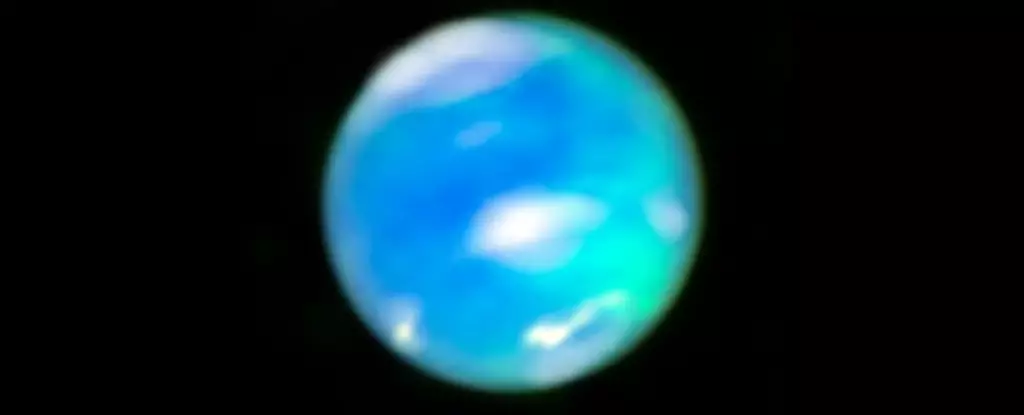The universe is filled with wonders, yet some remain hidden, cloaked in mystery, until technology catches up with the extraordinary. One such wonder, Neptune’s aurora, has recently graced our view, showcasing the sapphire-hued planet in a way never before witnessed. Thanks to the advanced capabilities of the James Webb Space Telescope (JWST), astronomers have managed to reveal this elusive phenomenon in near-infrared light. Until now, Neptune’s auroras were the last enigma among the planets in our Solar System, obscured by the immense distance and the inherent limitations of previous technology. The unveiling of these ethereal lights is not just a triumph for science but a dazzling reminder of nature’s grandeur beyond our terrestrial existences.
The Dance of Particles and Their Cosmic Addresses
Auroras, in essence, are cosmic performances, where charged particles from the solar wind collide with a planet’s magnetic field and atmosphere. On Earth, this spectacle unfolds in vibrant displays of color, lighting up our night sky and captivating onlookers. Here, the magnetic field’s poles serve as the dumping grounds for incoming solar particles. However, Neptune presents a fascinating twist: its auroras shimmer near the equator. The revelation that a planet with such a skewed magnetic field could produce beautiful auroras is a striking testament to the diversity of celestial phenomena. This unconventional characteristic prompts reflection on the variety of interactions between solar winds and planetary atmospheres throughout the cosmos.
Jupiter and Saturn: Giants of Auroral Energy
As we draw comparisons across our solar neighbors, it becomes evident that not all auroras are created equally. Jupiter, the solar system’s giant, boasts the most powerful and energetic auroras, radiating in bright ultraviolet light. This celestial titan illuminated the potential for auroras long before Neptune made its understated debut. Saturn also joins the ranks, exhibiting similar ultraviolet spectacles, while smaller planets like Mars and Venus play host to their own distinct styles. Each planet’s auroras tell a different story, acting as cosmic fingerprints that reflect their unique atmospheres and magnetic fields.
In stark contrast is Mercury, whose lack of an atmosphere translates to a curious aurora phenomenon in X-ray fluorescence. Therefore, the significance of Neptune’s auroras extends beyond mere beauty; they provide essential insights into how planets interact with stellar forces—an intersection of physics, chemistry, and celestial art.
An Astronomical Journey: The Road to Discovery
The process to reveal Neptune’s auroras has been fraught with challenges, primarily due to the vast distance separating the ice giant from the Sun. Each of Neptune’s orbits occurs approximately thirty times farther than Earth’s, which has made it difficult to ascertain its atmospheric behavior and auroral activities. Early assumptions about the intensity and presence of auroras were hindered by outdated temperature readings, leaving scientists with a skewed understanding. The JWST’s sensitivity and capacity to delve deep into the infrared spectrum recently lit the way forward, confirming phenomena thought to be mere speculation until now.
A dedicated team of astronomers, under the leadership of Henrik Melin from Northumbria University, meticulously analyzed the JWST’s findings. Their discovery of the trihydrogen cation (H3+) in Neptune’s atmosphere has been pivotal in mapping the planet’s auroras and shifting our understanding of how planetary magnetic fields can influence auroral activity in unexpected ways.
The Future of Exoplanet Exploration
Neptune’s auroras mark not just a momentous achievement within our own Solar System, but they set a significant precedent for celestial research and exploration of exoplanets. The newfound ability to detect and analyze auroras using precious spectrometer data heralds an era where we may begin to determine the atmospheric compositions and stellar interactions of distant worlds orbiting alien stars. Understanding auroras could even extend to the search for life beyond Earth, offering critical clues about other planets that might host habitability.
In a cosmos where each celestial body is woven into an intricate tapestry of forces, the revelations surrounding Neptune’s aurora only amplify our awe and appreciation for the universe. By harnessing science gently nudged forward by technology, we find ourselves painted a richer, more vibrant picture of our celestial neighborhood. The journey of discovery continues, prompting enthusiastic inquiry into the wonders that lie just beyond our reach.


Leave a Reply